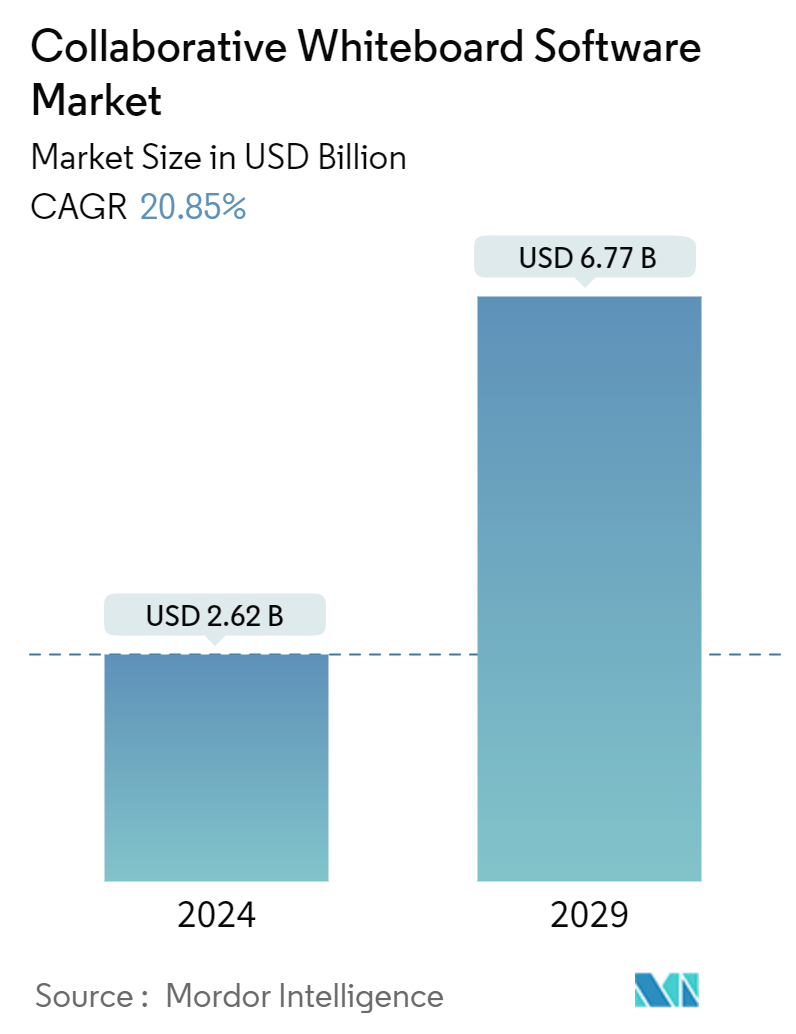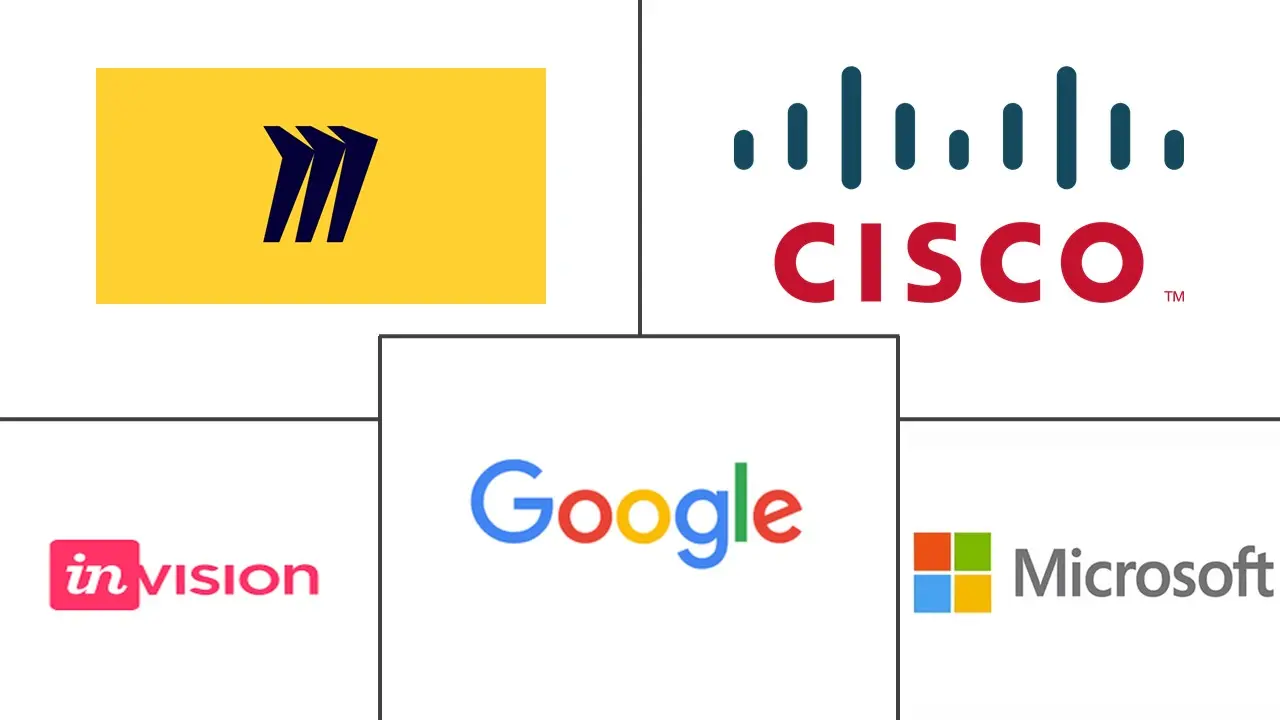Market Size of Collaborative Whiteboard Software Industry

| Study Period | 2019 - 2029 |
| Market Size (2024) | USD 2.62 Billion |
| Market Size (2029) | USD 6.77 Billion |
| CAGR (2024 - 2029) | 20.85 % |
| Fastest Growing Market | Asia Pacific |
| Largest Market | North America |
| Market Concentration | Medium |
Major Players
*Disclaimer: Major Players sorted in no particular order |
Collaborative Whiteboard Software Market Analysis
The Collaborative Whiteboard Software Market size is estimated at USD 2.62 billion in 2024, and is expected to reach USD 6.77 billion by 2029, growing at a CAGR of 20.85% during the forecast period (2024-2029).
- Collaborative whiteboard software provides a digital platform where multiple users can simultaneously share and edit content from their respective devices. Replacing its physical counterpart, this tool is versatile for designing, saving, and sharing content, fostering seamless collaborative communication.
- The demand for collaboration tools surged as millions shifted to remote work. In 2023, Microsoft Teams, with 320 million subscribers, notably served 91% of Fortune 100 companies. Global Enterprises, including Ernst & Young, SAP, Continental AG, and Accenture, are known for their substantial workforce and have embraced Microsoft Teams for their communication needs. MS Teams can be integrated with the Microsoft Whiteboard software tool, which shows the demand for the market studied.
- Design and project management teams predominantly favor these tools. They offer an intuitive and user-friendly content-sharing space, benefiting management groups in various disciplines. While most collaborative whiteboard solutions stand alone, some are integrated into other design software or visual collaboration platforms. As teams become more geographically dispersed, the onus of disseminating information among team members intensifies, bolstering coordination efforts. Effective task coordination in both collocated and distributed teams supports the market’s growth in all the end-user segments.
- However, challenges like inadequate training, misuse, underutilization, and subscription wastage hinder the market's growth. Subscriptions lose value if team members cannot effectively leverage their collaboration tools. Hence, ensuring user-friendly interfaces and comprehensive training from organizations become pivotal for collaborative whiteboard software developers.
- Since the onset of COVID-19, the global workforce has seen a rapid surge in remote work, increasing the need for robust communication and collaboration tools. In response, collaborative whiteboard software solutions have emerged as a pivotal player, ensuring productivity remains intact. Many organizations are eyeing a shift toward either partial or complete remote work setups.
Collaborative Whiteboard Software Industry Segmentation
Collaborative whiteboard software provides a shared, singular, and open design space where collaborators can simultaneously edit and share content from their respective devices. A collaborative whiteboard tool often resembles a physical whiteboard. These solutions include a spread of features that allow users to design, communicate, save, and share content in a customizable space.
The collaborative whiteboard software market is segmented by operating system (Windows and web, iOS, and Android), deployment mode (on-premise and cloud), organization size (large enterprises and small and medium enterprises), end-user vertical (BFSI, Healthcare, education, IT and telecommunications, and other end-user verticals), and Geography (North America, Europe, Asia-Pacific, Latin America, and Middle East and Africa). The market sizes and forecasts are provided in terms of value (USD) for all the above segments.
| By Operating System | |
| Windows and Web | |
| iOS | |
| Android |
| By Deployment Mode | |
| On-premise | |
| Cloud |
| By Organization Size | |
| Large Enterprises | |
| Small and Medium Enterprises |
| By End-user Vertical | |
| BFSI | |
| Healthcare | |
| Education | |
| IT and Telecommunications | |
| Other End-user Verticals |
| By Geography | |
| North America | |
| Europe | |
| Asia-Pacific | |
| Latin America | |
| Middle East and Africa |
Collaborative Whiteboard Software Market Size Summary
The collaborative whiteboard software market is poised for substantial growth, driven by the increasing adoption of remote and hybrid work models post-COVID-19. These tools provide a digital space for real-time collaboration, allowing teams to share, edit, and communicate content seamlessly, much like a physical whiteboard. The demand for such software has surged as organizations seek to enhance productivity, improve scheduling, and facilitate knowledge sharing among distributed teams. The market is characterized by a mix of standalone products and those integrated into broader design or visual collaboration platforms, catering primarily to design and project management teams. Despite the challenges of user training and subscription optimization, the market is expected to expand significantly as businesses continue to embrace flexible work arrangements.
North America holds a prominent position in the collaborative whiteboard software market, with a significant share attributed to the region's rapid adaptation to remote work during the pandemic. The focus on digital transformation and hybrid work culture has led to increased investments in collaboration platforms, presenting opportunities for vendors. Key players, including Microsoft, Google, and emerging niche companies like Miro and Crayon, are intensifying competition by offering innovative features and competitive pricing. The market is further bolstered by product innovations and strategic partnerships, such as Cisco's integration of Apple AirPlay with Webex products. As organizations prioritize effective collaboration tools to support their evolving work environments, the market for collaborative whiteboard software is expected to witness dynamic growth and increased vendor activity.
Collaborative Whiteboard Software Market Size - Table of Contents
-
1. MARKET INSIGHTS
-
1.1 Market Overview
-
1.2 Industry Attractiveness - Porter's Five Forces Analysis
-
1.2.1 Bargaining Power of Suppliers
-
1.2.2 Bargaining Power of Consumers
-
1.2.3 Threat of New Entrants
-
1.2.4 Threat of Substitutes
-
1.2.5 Intensity of Competitive Rivalry
-
-
1.3 Value Chain Analysis
-
1.4 Assessment of the Impact of COVID-19 on the Industry
-
1.5 Types of Collaborative Whiteboards
-
-
2. MARKET SEGMENTATION
-
2.1 By Operating System
-
2.1.1 Windows and Web
-
2.1.2 iOS
-
2.1.3 Android
-
-
2.2 By Deployment Mode
-
2.2.1 On-premise
-
2.2.2 Cloud
-
-
2.3 By Organization Size
-
2.3.1 Large Enterprises
-
2.3.2 Small and Medium Enterprises
-
-
2.4 By End-user Vertical
-
2.4.1 BFSI
-
2.4.2 Healthcare
-
2.4.3 Education
-
2.4.4 IT and Telecommunications
-
2.4.5 Other End-user Verticals
-
-
2.5 By Geography
-
2.5.1 North America
-
2.5.2 Europe
-
2.5.3 Asia-Pacific
-
2.5.4 Latin America
-
2.5.5 Middle East and Africa
-
-
Collaborative Whiteboard Software Market Size FAQs
How big is the Collaborative Whiteboard Software Market?
The Collaborative Whiteboard Software Market size is expected to reach USD 2.62 billion in 2024 and grow at a CAGR of 20.85% to reach USD 6.77 billion by 2029.
What is the current Collaborative Whiteboard Software Market size?
In 2024, the Collaborative Whiteboard Software Market size is expected to reach USD 2.62 billion.

